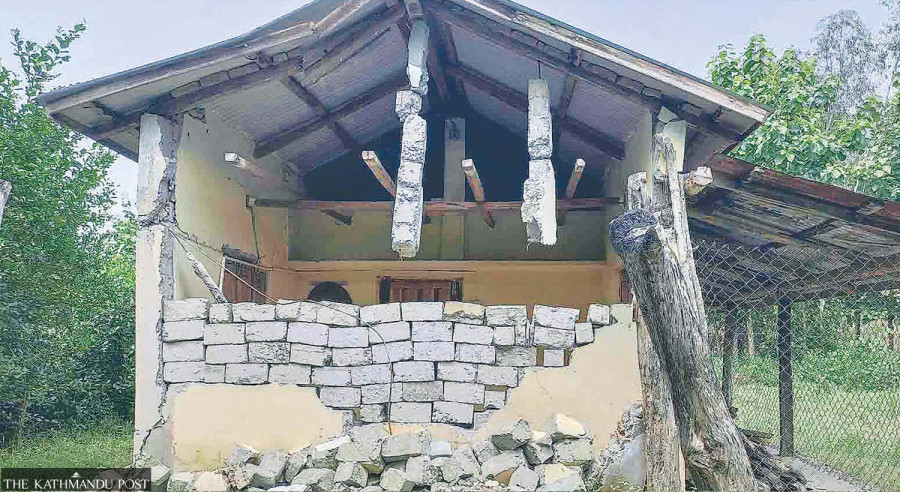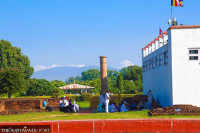Lumbini Province
Khata bio-corridor settlers in constant fear of wildlife
There are 4,802 households along the 24-km pathway between the Bardiya National Park and bordering Katarniaghat Wildlife Sanctuary of India.
Kamal Panthi
Jogipure Chaudhary, a landless squatter from ward 3 of Madhuwan Municipality, spends his nights at a relative’s house in Dhanaura due to fear of elephant attack.
“We can’t stay at home after dusk since the wild animals from the forests enter the settlement,” said Chaudhary.
Last month, on August 26, a wild elephant demolished Chaudhary’s house. And last year also a herd of elephants had torn down his home. Chaudhary and his family members had survived as they managed to flee.
The settlement of landless people, which is near the Nepal-India border, lies along the bio-corridor through which wild animals move to and from the Bardiya National Park and Katarniaghat Wildlife Sanctuary of India. Elephants in herds pass through the settlement almost every day.
Bhandhuwa Tharu, another local, is worried about sustenance this year since wild elephants destroyed his maize and paddy fields a few days ago.
“With the crops destroyed, I don’t know how to feed the family this year,” said Tharu. “I heard that the government provides compensation for the damaged crops and properties. But I have not received any compensation so far.”
Bandhuwa owns five kattha [1 kattha is 338.63 sq metres] of land that the government provided a few years ago. He planted maize and paddy, but the wildlife, mainly the elephants, destroyed them. “The elephants ravage the fields during the harvest season.”
On September 4, a herd of elephants entered a cornfield at Bhagaraiya in Madhuwan-3 and destroyed maize planted in 10 kattha of land. According to Laxmi Chand, a local, the herd of around 25 to 30 elephants entered the settlement and wreaked havoc.
The residents of various settlements in Madhuwan are hugely affected due to the recurring damage caused by wildlife.
Wild elephants destroyed the house of Ram Prasad Tharu twice last year. “The tuskers dismantled my house last year. I took a loan and rebuilt the house. But the elephants destroyed that too last week,” said Ram Prasad of Madhuwan-3 who is taking shelter at Dhanaura.
According to Ram Prasad, the landless people started living near the Nepal-India border in Madhuwan-3 in the 1990s. There are settlements at Dhanaura, Bhagaraiya and Bipatpur areas of Madhuwan-3.
“The villagers are in abject terror of wild animals. Once it’s evening, people cannot come out of their houses. We stay awake at night to chase away elephants by beating drums and lighting bonfires,” said Prem Pun Magar of Madhuwan-3.
Settlements along the Khata bio-corridor, a 24-km pathway along the shared border of Bardiya National Park in Nepal and Katarniaghat Wildlife Sanctuary in India, are under constant threats from the wildlife that use the corridor.
According to Santosh Chaudhary, assistant forest officer at Khata Range Post, wild elephants have destroyed eight houses along the corridor over the past two months. The tuskers demolished three houses in the landless settlement, two in Khothiyaghat of Madhuwan-3 and three other houses at Majhara of Rajapur Municipality-10.
According to Santosh, the tuskers killed three people and destroyed 10 houses last year along the Khata bio-corridor. Besides elephants, the bio-corridor is also frequented by rhinos, leopards and monkeys. “Tigers and leopards enter the settlements and kill domesticated animals while monkeys destroy crops, mainly maize,” said Dhana Bahadur Khatri of Bhagaraiya in Madhuwan-3.
The Postal Highway connects Gulariya, the district headquarters of Bardiya, with the Rajapur area across the Karnali River through the Khata bio-corridor. One has to cross a dense forest about two kilometres long while travelling along the Gulariya-Rajapur section. Wild animals like elephants, tigers, leopards and rhinos attack people while crossing the road section.
“Wild animals often move to and from Bardiya National Park and Katarniaghat Wildlife Sanctuary through the Gulariya-Rajapur road section. Travellers should be cautious while passing through the road through the forest,” said Bhadai Tharu, a conservationist based in Bardiya.
Conservationists and people’s representatives are worried about the increasing incidents of human-animal conflict in the area. “The authorities should provide compensation for the damage caused by wildlife. Also, the government should develop programmes to engage the locals in income-generating activities, so that they don’t have to rely on forest resources for livelihood. This would greatly minimise human-animal conflict,” said Min Thapa, the ward chairman of Madhuwan-1.
The forest area in the Khata bio-corridor covers around 202 square kilometres. According to the Khata Forest Coordination Committee, there are a total of 4,802 households in various settlements along the corridor. Security personnel and conservation officials urge people not to venture into the forest after dusk.
“We have imposed a ban on entering the forest areas after dusk. Besides saving crops and other properties, people have a tough time protecting themselves from wild animals,” said Bam Bahadur Kunwar, Armed Police Force inspector at the Border Outpost in Bhagaraiya.
According to the data of the Division Forest Office, in the past three years, 12 people have lost their lives in tiger attacks along the Khata corridor alone. In the district, at least 27 people have died in various wildlife attacks during the same time period.




 15.12°C Kathmandu
15.12°C Kathmandu










